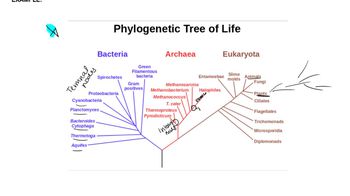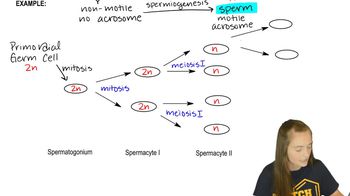Table of contents
- 1. Introduction to Genetics51m
- 2. Mendel's Laws of Inheritance3h 37m
- 3. Extensions to Mendelian Inheritance2h 41m
- 4. Genetic Mapping and Linkage2h 28m
- 5. Genetics of Bacteria and Viruses1h 21m
- 6. Chromosomal Variation1h 48m
- 7. DNA and Chromosome Structure56m
- 8. DNA Replication1h 10m
- 9. Mitosis and Meiosis1h 34m
- 10. Transcription1h 0m
- 11. Translation58m
- 12. Gene Regulation in Prokaryotes1h 19m
- 13. Gene Regulation in Eukaryotes44m
- 14. Genetic Control of Development44m
- 15. Genomes and Genomics1h 50m
- 16. Transposable Elements47m
- 17. Mutation, Repair, and Recombination1h 6m
- 18. Molecular Genetic Tools19m
- 19. Cancer Genetics29m
- 20. Quantitative Genetics1h 26m
- 21. Population Genetics50m
- 22. Evolutionary Genetics29m
9. Mitosis and Meiosis
Development of Animal Gametes
Problem 23
Textbook Question
Wolves and coyotes can interbreed in captivity; and now, because of changes in their habitat distribution, they may have the opportunity to interbreed in the wild. To examine this possibility, mitochondrial DNA from wolf and coyote populations throughout North America—including habitats where the two species both reside—was analyzed, and a phylogenetic tree was constructed from the resulting data (see Section 1.4 for details on how this is accomplished). Sequence from a jackal was used as an outgroup and a sequence from a domestic dog was included, demonstrating wolves as the origin of domestic dogs. What do you conclude about the possibility that interspecific hybridization occurred between wolves and coyotes on the basis of this phylogenetic tree?
 Verified step by step guidance
Verified step by step guidance1
Identify the purpose of using mitochondrial DNA in the study, which is to trace maternal lineage and assess genetic relationships between species.
Understand the role of the outgroup (jackal) in the phylogenetic tree, which is to provide a point of reference for determining the evolutionary relationships among the species being studied.
Examine the placement of wolves, coyotes, and domestic dogs in the phylogenetic tree to assess their genetic relatedness and potential for interbreeding.
Look for evidence of shared genetic markers or close clustering of wolf and coyote sequences in the phylogenetic tree, which may suggest past interspecific hybridization.
Consider the implications of the phylogenetic tree's structure on the possibility of interbreeding in the wild, taking into account the historical and current habitat distributions of wolves and coyotes.
Recommended similar problem, with video answer:
 Verified Solution
Verified SolutionThis video solution was recommended by our tutors as helpful for the problem above
Video duration:
2mPlay a video:
Was this helpful?
Key Concepts
Here are the essential concepts you must grasp in order to answer the question correctly.
Interspecific Hybridization
Interspecific hybridization refers to the mating and reproduction between individuals of different species, resulting in hybrid offspring. This phenomenon can occur when species share overlapping habitats and have compatible reproductive mechanisms. In the context of wolves and coyotes, understanding the potential for hybridization is crucial for assessing their evolutionary relationships and ecological impacts.
Recommended video:
Guided course

Drosophila P Element
Phylogenetic Trees
Phylogenetic trees are graphical representations that illustrate the evolutionary relationships among various species based on genetic data. They are constructed using molecular sequences, such as mitochondrial DNA, to determine how closely related different species are. The branching patterns of the tree indicate common ancestry and divergence, which can help infer the likelihood of interspecific hybridization.
Recommended video:
Guided course

Phylogenetic Trees
Mitochondrial DNA Analysis
Mitochondrial DNA (mtDNA) analysis involves studying the genetic material found in mitochondria, which is inherited maternally and can provide insights into evolutionary history. Because mtDNA evolves relatively quickly, it is useful for examining recent evolutionary events, such as hybridization. In this case, analyzing mtDNA from wolves and coyotes helps determine their genetic similarities and the potential for interbreeding.
Recommended video:
Guided course

Chi Square Analysis

 21:21m
21:21mWatch next
Master Gamete Development with a bite sized video explanation from Kylia Goodner
Start learningRelated Videos
Related Practice


